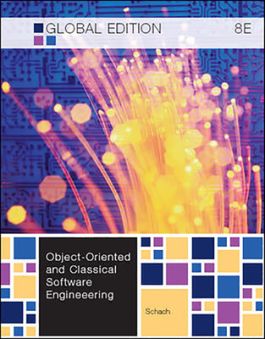Object-Oriented and Classical Software Engineering
8th Edition
0071081712
·
9780071081719
© 2011 | Published: October 4, 2010
Integrating case studies to show the object oriented approach to software engineering, Object-Oriented and Classical Software Engineering, 8/e presents an excellent introduction to software engineering fundamentals, covering both traditional and obje…
Read More
Receive via shipping:
- Colour, print bound version of the complete text
Part One
Chapter 1 The Scope of Software Engineering
Chapter 2 Software Life-Cycle Models
Chapter 3 The Software Process
Chapter 4 Teams
Chapter 5 The Tools of the Trade
Chapter 6 Testing
Chapter 7 From Modules to Objects
Chapter 8 Reusability and Portability
Chapter 9 Planning and Estimating
Part Two
Chapter 10 Key Material from Part A
Chapter 11 Requirements
Chapter 12 Classical Analysis
Chapter 13 Object-Oriented Analysis
Chapter 14 Design
Chapter 15 Implementation
Chapter 16 Postdelivery Maintenance
Chapter 17 More on UML
Chapter 18 Emerging Technologies
Chapter 2 Software Life-Cycle Models
Chapter 3 The Software Process
Chapter 4 Teams
Chapter 5 The Tools of the Trade
Chapter 6 Testing
Chapter 7 From Modules to Objects
Chapter 8 Reusability and Portability
Chapter 9 Planning and Estimating
Part Two
Chapter 10 Key Material from Part A
Chapter 11 Requirements
Chapter 12 Classical Analysis
Chapter 13 Object-Oriented Analysis
Chapter 14 Design
Chapter 15 Implementation
Chapter 16 Postdelivery Maintenance
Chapter 17 More on UML
Chapter 18 Emerging Technologies
Chapter 4 Teams
Chapter 5 The Tools of the Trade
Chapter 6 Testing
Chapter 7 From Modules to Objects
Chapter 8 Reusability and Portability
Chapter 9 Planning and Estimating
Part Two
Chapter 10 Key Material from Part A
Chapter 11 Requirements
Chapter 12 Classical Analysis
Chapter 13 Object-Oriented Analysis
Chapter 14 Design
Chapter 15 Implementation
Chapter 16 Postdelivery Maintenance
Chapter 17 More on UML
Chapter 18 Emerging Technologies
Chapter 6 Testing
Chapter 7 From Modules to Objects
Chapter 8 Reusability and Portability
Chapter 9 Planning and Estimating
Part Two
Chapter 10 Key Material from Part A
Chapter 11 Requirements
Chapter 12 Classical Analysis
Chapter 13 Object-Oriented Analysis
Chapter 14 Design
Chapter 15 Implementation
Chapter 16 Postdelivery Maintenance
Chapter 17 More on UML
Chapter 18 Emerging Technologies
Chapter 8 Reusability and Portability
Chapter 9 Planning and Estimating
Part Two
Chapter 10 Key Material from Part A
Chapter 11 Requirements
Chapter 12 Classical Analysis
Chapter 13 Object-Oriented Analysis
Chapter 14 Design
Chapter 15 Implementation
Chapter 16 Postdelivery Maintenance
Chapter 17 More on UML
Chapter 18 Emerging Technologies
Part Two
Chapter 10 Key Material from Part A
Chapter 11 Requirements
Chapter 12 Classical Analysis
Chapter 13 Object-Oriented Analysis
Chapter 14 Design
Chapter 15 Implementation
Chapter 16 Postdelivery Maintenance
Chapter 17 More on UML
Chapter 18 Emerging Technologies
Chapter 11 Requirements
Chapter 12 Classical Analysis
Chapter 13 Object-Oriented Analysis
Chapter 14 Design
Chapter 15 Implementation
Chapter 16 Postdelivery Maintenance
Chapter 17 More on UML
Chapter 18 Emerging Technologies
Chapter 13 Object-Oriented Analysis
Chapter 14 Design
Chapter 15 Implementation
Chapter 16 Postdelivery Maintenance
Chapter 17 More on UML
Chapter 18 Emerging Technologies
Chapter 15 Implementation
Chapter 16 Postdelivery Maintenance
Chapter 17 More on UML
Chapter 18 Emerging Technologies
Chapter 17 More on UML
Chapter 18 Emerging Technologies
Integrating case studies to show the object oriented approach to software engineering, Object-Oriented and Classical Software Engineering, 8/e presents an excellent introduction to software engineering fundamentals, covering both traditional and object-oriented techniques. While maintaining a unique organization with Part I covering underlying software engineering theory, and Part II presenting the more practical life cycle, the eighth edition includes significant revision to problems, new content, as well as a new chapter to enable instructors to better-utilize the book in a one-semester course. Complementing this well-balanced approach is the straightforward, student-friendly writing style, through which difficult concepts are presented in a clear, understandable manner.

